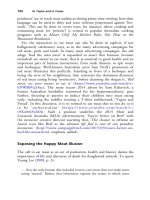The palgrave international handbook of a 222
Bạn đang xem bản rút gọn của tài liệu. Xem và tải ngay bản đầy đủ của tài liệu tại đây (24.8 KB, 1 trang )
Collecting Wildlife
217
claims to being a recreational activity than trophy hunting which is more
closely associated with the hunting experience and dominion over animals
and wild places. Yet, while in principle legal trophy hunting is regulated and
monitored by law enforcement and conservation authorities, the large sums
of money involved dictate that illegal activity is closely associated with trophy
hunting which in reality is poorly regulated, subject to weak enforcement,
lacklustre prosecutorial efforts and provides opportunities for corruption
(Lindsey et al. 2006). Thus regulatory and legislative frameworks that govern
the trophy hunting industry require improvement (Lindsey et al. 2006) and
also need dedicated resources to be in place, not only aimed at ensuring that
the ‘legal’ trophy hunting industry is effectively monitored and its regulations
complied with, but that the illegal aspects of trophy hunting are properly
enforced. Seemingly ‘minor’ breaches of sport and trophy hunting regulations indicated by illegal activities carried out as part of legal trophy hunting
show a disregard for animals that leads to them being considered only in
respect of their value as trophies and subjects of the hunt. The more serious
illegal poaching and trophy hunting that takes place, also illustrates how
illegal commercial activity firmly views animals as disposable. Thus it
becomes a form of animal abuse that ignores the conservation imperatives
of legal sport and trophy hunting which is intended to represent sustainable
use of wildlife and ignores the species conservation imperative of preserving
rare and threatened animals for future generations.
Collecting as Animal Abuse: Some Preliminary
Conclusions
Debates in theology, criminology and the study of animal law concerning the
rights of animals and the moral wrong of inflicting harm on other sentient
beings have explored the relationship between man and non-human animals,
the need for legal rights for animals and issues of animal abuse and the need
for increased standards of animal welfare (see Ascione 2008; Scruton 2006;
Sunstein and Nussbaum 2006 and Wise 2000). Green scholars have exposed
ecological and species injustice as well as identifying areas where mainstream
criminal justice will benefit from a green perspective while ‘general’ criminal
justice techniques can be applied to green crimes. Species justice concerns
mean consideration of both direct and indirect harms to nonhuman animals
and the rejection of speciesist notions of justice that may contextualise some
forms of animal abuse as victimless crime. Within green criminology,









